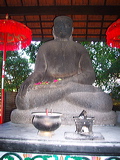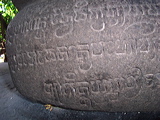Joko Dolog
 A
stone image of the Buddha Akshobya, curiously
matching the description of the 'missing statue'
at Candi Jawi, can be found today in a small,
secluded park in Surabaya. Known locally as
Joko Dolog, the statue displays a lengthy sanskrit
inscription, carved neatly around its base.
When it was translated for the first time early
in this century, the inscription was found
to reveal important historical information
dating from the period immediately prior to
the founding of Majapahit. Executed in the
year 1289 by a Buddhist scribe named Nada,
the contents are roughly as follows: A
stone image of the Buddha Akshobya, curiously
matching the description of the 'missing statue'
at Candi Jawi, can be found today in a small,
secluded park in Surabaya. Known locally as
Joko Dolog, the statue displays a lengthy sanskrit
inscription, carved neatly around its base.
When it was translated for the first time early
in this century, the inscription was found
to reveal important historical information
dating from the period immediately prior to
the founding of Majapahit. Executed in the
year 1289 by a Buddhist scribe named Nada,
the contents are roughly as follows:
It is said that in times long past the sage
Mpu Bharada divided the land of Java into the
kingdoms of Janggala and Panjalu (Kediri), with
the purpose of settling a dispute between two
brothers over the right to royal succession.
The division was created magically, by means
of holy water sprinkled out of a jar from the
sky. Since the reign of Sri Wishnuwardhana, however,
the country had been re-united, to the joy and
benefit of all. The present ruler, of whom the
statue was said to have been a portrait, was
Wishnuwardhana's son, Kertanagara, who had commissioned
the image as a symbol of this re-unification.
 The information contained in the Joko Dolog
inscription is especially interesting because
it appears to establish the authenticity of certain
historical figures and events, previously known
only from ancient Javanese literature. The story
of the division of Java by the sage Mpu Bharada
is of course well known, and refers to the reign
of King Airlangga in the 11th century. On the
other hand, by giving Wishnuwardhana the credit
for having re-united the country, the inscription
has tended to cast doubt upon the reliability
of traditional literary sources, particularly
with regard to the story of Ken Angrok and Ken
Dedes, which has by some been dismissed as a
complete fabrication. The information contained in the Joko Dolog
inscription is especially interesting because
it appears to establish the authenticity of certain
historical figures and events, previously known
only from ancient Javanese literature. The story
of the division of Java by the sage Mpu Bharada
is of course well known, and refers to the reign
of King Airlangga in the 11th century. On the
other hand, by giving Wishnuwardhana the credit
for having re-united the country, the inscription
has tended to cast doubt upon the reliability
of traditional literary sources, particularly
with regard to the story of Ken Angrok and Ken
Dedes, which has by some been dismissed as a
complete fabrication.
Yet, since the discovery in 1975 of a number
of inscribed copper sheets originating from the
region of Kediri, new light has been shed on
the early years of the Singosari period. Known
as the inscription of Mula Malurung, issued by
King Kertanagara in 1255, it mentions the names
of Wishnuwardhana, Tohjaya, as well as a number
of other kings whose names have been hitherto
unknown to historians. Finally, and most interesting,
the Mula Malurung inscription appears to suggest
the existence of Ken Angrok, thus at least confirming
an historical basis for a story which was beginning
to fade entirely into the realm of myth.
Click Here...
Photos Gallery
More
information about Mojo Fruit, please Click
here.. |












